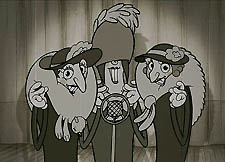Vive la Chomet!
The Triplets of Belleville
 |
French animator Sylvain Chomet’s The Triplets of Belleville is one of those movies that so thoroughly envelopes you in its own world, so thoroughly commands every bit of your attention, so thoroughly enchants and mesmerizes, that it almost deserves a standing ovation even before the projector rolls. It’s a triumph of style and substance, dispensing equal parts unbridled glee and profound melancholy. In a near-wordless 78 minutes, it evokes fond memories of animation legends Tex Avery and Walt Disney, and France’s own live-action master of cinema, Jacques Tati. And yet for all its external references, it’s a singular achievement, a work of spectacular imagination, one unlike anything else you’re ever likely to see. Which, of course, is the beauty of animation. At its best, it transports us to another world, rooting itself firmly in an alternate reality that seems familiar but remains defiantly bizarre. Triplets, which last week was Oscar-nominated alongside Brother Bear and Finding Nemo under the Outstanding Animated Feature category, is perhaps the most complex and artistically-involved of the three films. Bear has beauty and warmth, Nemo, charm and wit, but Triplets has all that plus sharp satirical bite. Moreover, it fully celebrates the old and the new — the rigors of hand-drawn animation and the streamlined opulence of computer-generated additives.
When all is said and done, the core story of finding and rescuing a loved one who’s been abducted isn’t all that much different from that of Nemo‘s. Madame Souza, an elderly woman with a club foot and big, inquisitive eyes, lives on the outskirts of Paris. Her expression seems fixed in a perpetual stern, serious state, though it’s impossible to ignore the undercurrent concern and adoration she has for her rotund grandson, Champion, a morose young lad who, it is implied, lost his parents to a terrible accident. Souza sets out to cheer the boy up. Nothing works — not even the frisky puppy, Bruno, she buys for him.
 |
Then she buys him a bike. And everything changes. The world comes alive.
Flash forward several years later — Madame Souza’s once idyllic country home has been overrun by industrialization. Bruno, meanwhile, has put on an astounding amount of weight (there’s a reason for the dog’s obesity, which Chomet eventually reveals in a coy, playful manner). More importantly, Madame Souza serves as a trainer for Champion, readying the now angular, muscular-thighed young man for the Tour de France. Champion, for his part, is little more than a vessel — he does as he’s told — mindlessly, serenely — and this becomes his undoing when he’s abducted by a pair of Mafioso henchmen who transport him and two others to the bloated metropolis of Belleville (a hybrid of Paris, Montreal and New York) for a ghastly purpose.
 |
The determined, fearless old lady and her dog travel to Belleville to rescue Champion. Once there, they find unlikely allies in the form of three old crones — the famed Triplets of Belleville — a one-time renowned Vaudeville singing act, now living an eccentric and oddball life in a run-down, sleazy hotel.
To reveal much more might spoil the fun and surprises Chomet has in store. But I will say this, you’re unlikely to ever forget the alarming and darkly funny sequence involving frogs.
 |
The Triplets of Belleville is exquisitely drawn — the backgrounds are finely detailed, abstract-tinged watercolors — and the primary characters move with a delicately-honed fluidity. The film opens with a rapturous black and white musical sequence that shows the Triplets in performance alongside Fred Astaire and Josephine Baker. There are moments where the action slows down a touch — Triplets isn’t as whiz-bang as most of the movies we’re used to sitting through — but patience has its payoffs, including a stormy trans-Atlantic ocean voyage that rivals anything in Master and Commander and the most improbably climactic car chase ever put to film. And then there’s the utterly hysterical encounter between Madame Souza and an annoyingly helpful Boy Scout.
|
Chomet the satirist spares no one. The French are given a sound skewering during the Tour de France sequence, as are the Americans, depicted here as huge, corpulent vessels of gluttony. I personally favored the depiction of the Mafia bosses and their coffin-shaped henchmen, as well as a rubber-limbed, obsequious maitre’d at a posh restaurant.
There’s an eye-popping vibrancy to Triplets that keeps it aloft. But the movie also has sober and unsettling side — a dark, understated sorrow occasionally cuts through the movie’s playful veneer. Still, I can’t imagine anyone leaving this movie and feeling as though they’ve been battered. Rather, Triplets of Belleville leaves you feeling content that there are still filmmakers in this world who understand the meaning of creation — and who realize that what they’re creating can become a piece of lasting art.
Support Metro Weekly’s Journalism
These are challenging times for news organizations. And yet it’s crucial we stay active and provide vital resources and information to both our local readers and the world. So won’t you please take a moment and consider supporting Metro Weekly with a membership? For as little as $5 a month, you can help ensure Metro Weekly magazine and MetroWeekly.com remain free, viable resources as we provide the best, most diverse, culturally-resonant LGBTQ coverage in both the D.C. region and around the world. Memberships come with exclusive perks and discounts, your own personal digital delivery of each week’s magazine (and an archive), access to our Member's Lounge when it launches this fall, and exclusive members-only items like Metro Weekly Membership Mugs and Tote Bags! Check out all our membership levels here and please join us today!

























